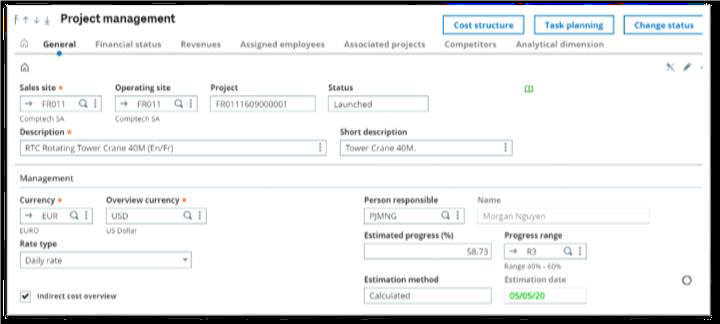As of April 2021, two releases (R1 and R2) of Sage X3 2021 are now available. Here’s a look at what’s new in the latest versions including a range of features that span finance, distribution, manufacturing, project management and more.
Update: Sage X3 2021 R3 is now available. Check out our Sage X3 2021 R3 release notes.
Update: Sage X3 2021 R3 is now available. Check out our Sage X3 2021 R3 release notes.
New Features for Finance
Several updates in finance are designed to streamline revenue recognition. This includes an enhanced way to define accounts for Actual revenue and/or Actual cost Column types. Based on the calculation basis chosen, a new window opens that lists all accounts in the main general ledger or main general analytical ledger. You can select as many accounts as you need with no character limits as well as export the list of accounts to Excel.
When it comes to outbound bank file management, you no longer need to manually define field separators when setting up output files in a CSV format. That means makes it faster and easier to define and manage bank file structures, so you can more easily meet banks CSV-type bank file formats. Plus, to reduce the need for separate payments you can now create multiple bank files from one remittance group depending on selected splitting criteria.
To better support the segregation of duties and secure AP and AR processes, payment remittance approvals in Sage X3 2021 have been enhanced. You can decide if payment approval is required to process a payment and create a bank file. Approvals are authorized at the user level and a bank file can only be created for payments where no authorization is required or for approved payments for manual and automatic remittances. Outgoing payments can be approved at the payment level or the manual remittance level, and mass approvals or mass removal of unapproved payments is available at the remittance level.
To better support the segregation of duties and secure AP and AR processes, payment remittance approvals in Sage X3 2021 have been enhanced. You can decide if payment approval is required to process a payment and create a bank file. Approvals are authorized at the user level and a bank file can only be created for payments where no authorization is required or for approved payments for manual and automatic remittances. Outgoing payments can be approved at the payment level or the manual remittance level, and mass approvals or mass removal of unapproved payments is available at the remittance level.
In Sage X3 2021, you can manage the entire bad debts process, which includes defining the types of bad debts managed (impairment, doubtful receivables, and write-offs) and the automatic journals and analytical dimensions applied for journal entries. Using the Bad debts inquiry function, you can search for all existing bad debts and filter by type, entity, company, and dates. When a you create a write-off, the related open item can no longer be used. If there are impairments created for this open item, an impairment reversal is automatically created.
Since Sage X3 is used worldwide, each new release takes into account country-specific localization and compliance issues. In Sage X3 2021 R1 and R2, a range of compliance updates have been applied to support local jurisdictional requirements in France, Germany, Ireland, Portugal, Spain, and others (check the release notes for full details). In particular for Canada, a new Canadian legislation pack provides dedicated settings like business partner tax rules, tax levels, tax determination codes, tax codes, document types, sequence number definitions, and journal codes assigned to the new Canadian legislation code CAN.
See Also: Sage X3 Keyboard Shortcuts
Since Sage X3 is used worldwide, each new release takes into account country-specific localization and compliance issues. In Sage X3 2021 R1 and R2, a range of compliance updates have been applied to support local jurisdictional requirements in France, Germany, Ireland, Portugal, Spain, and others (check the release notes for full details). In particular for Canada, a new Canadian legislation pack provides dedicated settings like business partner tax rules, tax levels, tax determination codes, tax codes, document types, sequence number definitions, and journal codes assigned to the new Canadian legislation code CAN.
See Also: Sage X3 Keyboard Shortcuts
Sage X3 2021 Distribution Enhancements
Here are a few highlights of new or improved functionality in Sage X3 2021 inventory management and distribution functions:
Sales Order Management (Credit Holds)
Sales order management has been enhanced to streamline the flow of orders impacted when credit limits are reached. Controls have been introduced to automatically return a sales order to credit hold if the value of the order has increased, or a new line has been added by a user who is not authorized to unlock orders.
Inventory Management (Accuracy and Traceability)
To ensure stock accuracy and traceability, you can now apply controls during stock issue on available stock at the effect date. This allows you to manage strict chronological stock flow when issuing stock for inventory valuation reasons.
Automated Data Collection
You can now use the Sage X3 Automated Data Collection (ADC) for Distribution. These functions, compatible with Android mobile devices, provide secure Shop floor Execution and Automation processes for purchase receipt, putaway, pick tickets, and much more.
See Also: Sage X3 Implementation & Deployment Options
Sales Order Management (Credit Holds)
Sales order management has been enhanced to streamline the flow of orders impacted when credit limits are reached. Controls have been introduced to automatically return a sales order to credit hold if the value of the order has increased, or a new line has been added by a user who is not authorized to unlock orders.
Inventory Management (Accuracy and Traceability)
To ensure stock accuracy and traceability, you can now apply controls during stock issue on available stock at the effect date. This allows you to manage strict chronological stock flow when issuing stock for inventory valuation reasons.
Automated Data Collection
You can now use the Sage X3 Automated Data Collection (ADC) for Distribution. These functions, compatible with Android mobile devices, provide secure Shop floor Execution and Automation processes for purchase receipt, putaway, pick tickets, and much more.
See Also: Sage X3 Implementation & Deployment Options
Product Setup Matrix Integration with Web Scheduling
Three new setup functions have been made available on the Setup > Manufacturing > Finite Scheduler Advanced submenu. You can these new functions when producing multiple products using common resources to organize the sequence of production and minimize the setup time between products and operations.
- Use the Attribute function to define custom attributes for products and product-site records, such as color or size.
- Use the Setup time matrix function to define a setup time matrix linking product attributes and values.
- Use the Optimization matrix function to define a setup time matrix for work centers.
Note: The product "setup matrix" functionality is only used with Sage X3 Web Scheduling or with a web scheduling solution developed by a third-party vendor. It is not used with Sage X3 work orders or scheduling.
Sage X3 2021 Project Management
Here are a few highlights of new or improved functionality in Sage X3 2021 project management functions:
Progress Billing
A new invoicing process - Progress billing - allows you to define and manage a billing plan, and bill a project according to its progress. Scheduled invoices associated with the sales order line are submitted according to the estimated progress status of the billing plan until the project is complete.
Progress Billing
A new invoicing process - Progress billing - allows you to define and manage a billing plan, and bill a project according to its progress. Scheduled invoices associated with the sales order line are submitted according to the estimated progress status of the billing plan until the project is complete.
Weekly Timesheet
To help employees track time spent on projects on a weekly basis, a new weekly timesheet function has been introduced. You can see a list of assigned tasks for an entire week and simply fill in time spent on an assignment line for the dedicated day. Employees can also manually add new lines in the timesheet to log time for an unassigned project, budget, or task.
Time Tracking on Non-project Activities
Employees can now record time for non-project activities such as administrative time, annual leave and sick leave, providing a more complete overview of time spent by an employee.
To help employees track time spent on projects on a weekly basis, a new weekly timesheet function has been introduced. You can see a list of assigned tasks for an entire week and simply fill in time spent on an assignment line for the dedicated day. Employees can also manually add new lines in the timesheet to log time for an unassigned project, budget, or task.
Time Tracking on Non-project Activities
Employees can now record time for non-project activities such as administrative time, annual leave and sick leave, providing a more complete overview of time spent by an employee.






